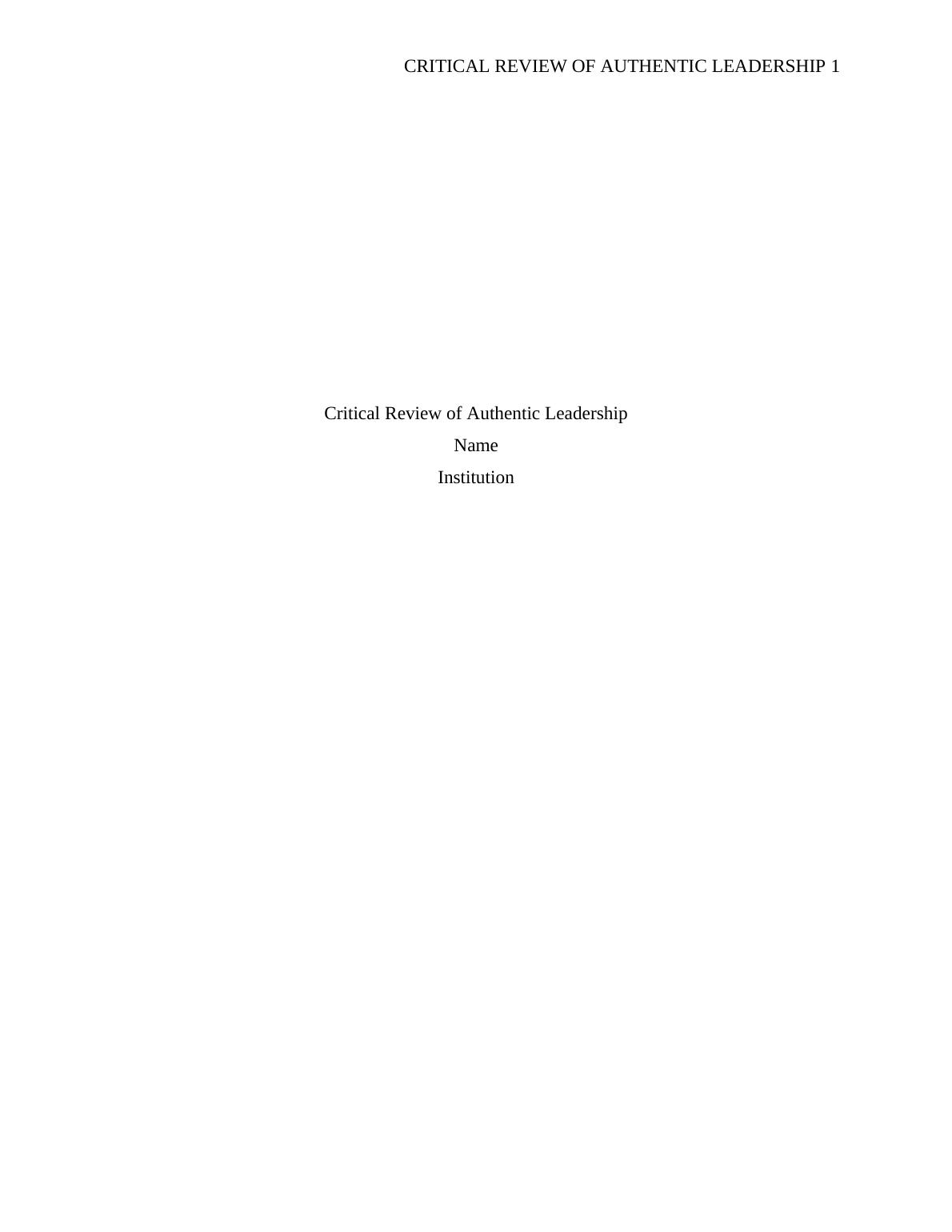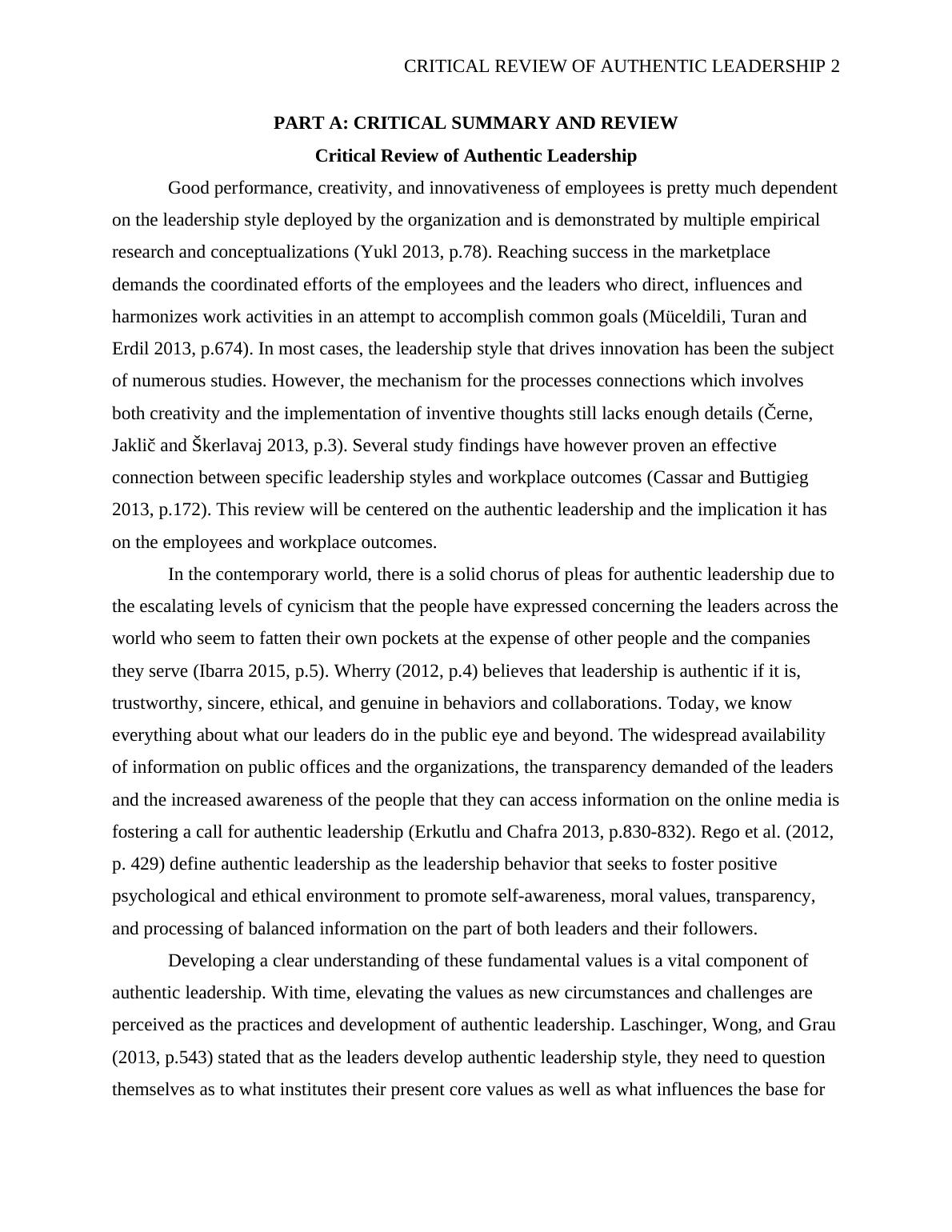Critical Review of Authentic Leadership Assignment
12 Pages4812 Words168 Views
Added on 2020-03-23
Critical Review of Authentic Leadership Assignment
Added on 2020-03-23
ShareRelated Documents
CRITICAL REVIEW OF AUTHENTIC LEADERSHIP 1Critical Review of Authentic LeadershipNameInstitution

CRITICAL REVIEW OF AUTHENTIC LEADERSHIP 2PART A: CRITICAL SUMMARY AND REVIEW Critical Review of Authentic LeadershipGood performance, creativity, and innovativeness of employees is pretty much dependenton the leadership style deployed by the organization and is demonstrated by multiple empirical research and conceptualizations (Yukl 2013, p.78). Reaching success in the marketplace demands the coordinated efforts of the employees and the leaders who direct, influences and harmonizes work activities in an attempt to accomplish common goals (Müceldili, Turan and Erdil 2013, p.674). In most cases, the leadership style that drives innovation has been the subject of numerous studies. However, the mechanism for the processes connections which involves both creativity and the implementation of inventive thoughts still lacks enough details (Černe, Jaklič and Škerlavaj 2013, p.3). Several study findings have however proven an effective connection between specific leadership styles and workplace outcomes (Cassar and Buttigieg 2013, p.172). This review will be centered on the authentic leadership and the implication it has on the employees and workplace outcomes.In the contemporary world, there is a solid chorus of pleas for authentic leadership due to the escalating levels of cynicism that the people have expressed concerning the leaders across theworld who seem to fatten their own pockets at the expense of other people and the companies they serve (Ibarra 2015, p.5). Wherry (2012, p.4) believes that leadership is authentic if it is, trustworthy, sincere, ethical, and genuine in behaviors and collaborations. Today, we know everything about what our leaders do in the public eye and beyond. The widespread availability of information on public offices and the organizations, the transparency demanded of the leaders and the increased awareness of the people that they can access information on the online media isfostering a call for authentic leadership (Erkutlu and Chafra 2013, p.830-832). Rego et al. (2012, p. 429) define authentic leadership as the leadership behavior that seeks to foster positive psychological and ethical environment to promote self-awareness, moral values, transparency, and processing of balanced information on the part of both leaders and their followers.Developing a clear understanding of these fundamental values is a vital component of authentic leadership. With time, elevating the values as new circumstances and challenges are perceived as the practices and development of authentic leadership. Laschinger, Wong, and Grau(2013, p.543) stated that as the leaders develop authentic leadership style, they need to question themselves as to what institutes their present core values as well as what influences the base for

CRITICAL REVIEW OF AUTHENTIC LEADERSHIP 3their key decisions and actions. The values and beliefs must include a more general principle rather than one's personal desires and must incorporate principles of how the leaders influence their followers by raising themselves and others to greater standards of ethical behavior (Treviäno & Nelson 2014, p.16 and Day et al. 2014, p.69). To add onto that, it is crucial to note that authentic leadership is not an object or entity that exists or fails to exist instead, this leadership style occurs over time.Algera and Lips-Wiersma (2012, p. 118) in the article ‘Radical Authentic Leadership,’ they sought to develop circumstances in which managers, leaders, and employees within an organization can be authentic. They argued that the way in which authentic leadership is currently being theorized, it may be difficult to accomplish its set objectives. The article addresses the inconsistencies and shortfalls in the existing theories to deliver an extended focus of the study. Four authenticity themes were identified including authenticity demands developingown meaning, authenticity is not intrinsically ethical, authenticity fails to imply value congruence, and authenticity is avoidable (Algera and Lips-Wiersma (2012, p. 122).Although authentic leadership previously acknowledged as authenticity to imply a complex concept, its effects have been glossed over and are yet to be followed from time to time. Proceeding along these lines would lead to authentic leadership as a management technique thereby undermining authentic leadership’s shared vision of increasing positive work and ethical behavior. Algera and Lips-Wiersma (2012, p. 129) studied the assertions of authentic leadership through an existential model of authenticity. The four themes identified emphasized on the significance of a person’s freedom and responsibility in being authentic as well as the connection and the responsibility of the collectiveness within a firm (Algera and Lips-Wiersma (2012, p. 129). The implications of the themes were carefully pursued. The expansion of theories of authentic leadership help put forward a more radical form of the leadership style where the emphasis is placed on the leaders to understanding the environment in which people within an organization act authentically. The authors offered that for authentic leadership to be theorized it must ask the question as to how people and the collective can stay current to the structural pressures of time, power, and purpose that will modify authenticity within organizations (Algera and Lips-Wiersma (2012, p. 128). It was concluded that this would result in a pretty much complicated and time-consuming study yetclaimed that the objective of authentic leadership is crucial to warrant the commitment that the

CRITICAL REVIEW OF AUTHENTIC LEADERSHIP 4study demands and that it has the potential to break through the existing impasses in the creation of leadership theory.Wang and Hsieh (2013, p. 613) sought to explore the implications of authentic leadershipon team members trust and involvement. Employee trust is a vital tool to foster cooperative relationships within an organization. Trust in leaders has been found to be one of the critical elements of employee engagement. Employee engagement is where an employee becomes involved, receives satisfaction, and enthusiasm for work. Data was collected from about 390 employees in 1,000 manufacturing companies in Taiwan (Wang and Hsieh 2013, p.617). In the study, hierarchical multiple regression methods were deployed to test the hypothesis (Wang and Hsieh 2013, p.618). The research findings ascertained that through employee trust, authentic leaders exercise close contacts with their followers, improve job and employee engagement contributing to a sustainable organization. The results established that the managers' consistency between the words, behaviors, and moral awareness are strongly related to members’ engagement (Wang and Hsieh 2013, p.617). At the same time, consistency between the managers’ words and behaviors are strongly related to members trust. In addition, it was revealeda positive connection between employee trust and engagement. There was a restricted mediating impact between employee trust, authentic leadership, and employee engagement. This research had its own drawbacks due to the fact that it used self-reported data from similar sources which could provide artificially inflated results which raised concerns of the common method variance (Wang and Hsieh 2013, p.622). To reduce this risk, several procedural remedies were applied which comprised protecting the respondents anonymity, counterbalancing question order, and psychological separation of measurement (Wang and Hsieh 2013, p.622). The core weakness of this study is that the researchers could not utilize the multilevel modeling on the variables thereby failing to shed light on and discover a more accurate implication of authentic leadership on employees’ behavior and attitude. All in all, the major strength of the article findings offered practical effects for the managers and the organization. Organizations must recognize the need for authentic leadership. The research demanded that leaders must hold specific conducts such asconsistency and integrity in behaviors, distribution, and delegation of roles, effective communication and showing apprehension (Wang and Hsieh 2013, p.621). In yet another study, Černe et al. (2014, p.1) examined the impact of authentic leadership on how it enhances employee job satisfaction. Studies were conducted to analyze how the two

End of preview
Want to access all the pages? Upload your documents or become a member.
Related Documents
Authentic Leadership, Leader-Member Exchange, and Psychological Capital: A Literature Reviewlg...
|13
|3803
|361
Positive Leadership Assesment Analysislg...
|9
|2964
|16
I have attached lecture slideslg...
|10
|3340
|19
Positive leadership.lg...
|9
|480
|3
Theories of Leadership and Organizational Ethics: An Overviewlg...
|12
|2887
|453
Reflective Thinking And Critical Thinkinglg...
|8
|1434
|14
